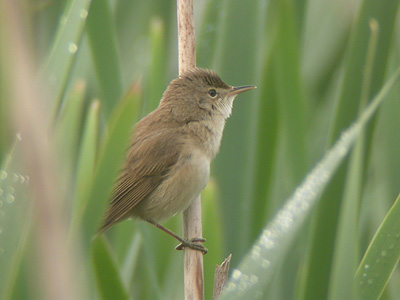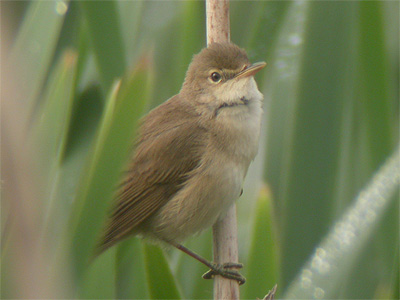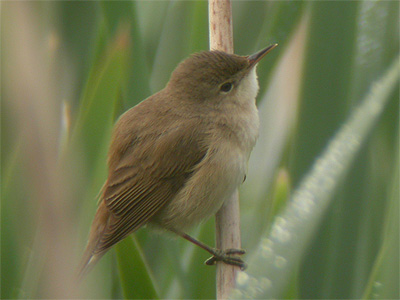

| Reed Warbler - a new breeding bird for Eakring 2005 | ||
 |
It's not often that a new
breeding species is added to a particular site' species
list (or can be due to habitat restriction) but a
surprising addition occured in the middle of May when a
male Reed Warbler took up residence at Eakring Flash. Events becoming even more surpising, when a second male arrived towards the end of the month, followed shortly afterwards a female which paired up with the first male. All this came five years after the only previous Spring Reed Warbler, along the old hedge on April 23rd 2000. This coincided with a day which was also notable for a pronounced number of migrant arrivals, numerous Wheatears and heavy rain. |
|
| ....... | ||
| Eakring Flash is not typical breeding Reed Warbler habitat and the species had proved to be so scarce in Spring, that it was never really thought of it as a potential breeding species. However, the subsequent arrival of three birds by the end of May 2005, means that many Spring birds have undoubtably been missed. Reed Warblers are secretive by nature and although the first male was found on May 15th, it showed only briefly just three times throughout the remaining period, until the end of the month. | ||
| ....... |
 |
The second male arrived
on May 29th, with a female seen with the first male two
days later on May 31st. They remained very secretive
during the first week of June and were rarely seen or
heard, whilst the second male sang for much of the day.
At the time of writing (08/06/05) it was still unpaired. Previous history of the Reed Warbler at Eakring Flash Reed Warbler has always been rare here and all records have come from Eakring Flash. Most records have referred to Autumn birds, particularly favouring Elders along the old hedge. Autumn records have involved birds in August and September. |
|
The above records roughly translate to three periods when migrant Reed Warblers are most likely to turn up during the Autumn months. Most records have come during late August/early September. Mid-August has also produced several records, before a series of late occurrences in mid-September. If records for genuine migrant Sedge Warblers (rather than locally breeding birds) are added, then there seems evidence for a direct association between the two species during return migration. Indeed, both species have been found in the same bush during mid-September. This could of course be coincidence due to the number of birds moving through at this time, but numbers of many of the other species peak during mid-August. |
|||||||||||||||||||||||||||||||||||
| ....... | ||
| Differences in
song and mimicry The differences between both males' singing, including the amount of song, length of singing and vocalisation variety was fairly considerable. The first male rarely sang for any length of time and always from the depth of the Bulrush bed or waterside Sallows. It was always very elusive and bursts of song were quiet and rather subdued, but typical Reed Warbler. The only mimicry noted from this male, were occasional short bursts of Sedge Warbler phrases. Although a female was'nt seen until May 31st, it is possible that one had been present much earlier. This could possibly have caused the more subdued song by this male. |
 |
|
| ....... | ||
| In complete
contrast, the second male was always much more prolonged
in it's singing and showed a far greater variety of
mimicry. It often sang openly and in full view for
lengthy periods and particularly favoured a small Osier
Willow, situated within the Bulrushes at the southern-end
of Eakring Flash. All the photographs on this page were
of this bird. Included within bursts of typical "chatty" song were realistic copies of Greenshank, Kestrel, Blue Tit, Sedge Warbler and the "hueet" alarm call of Chiffchaff and Willow Warbler. |
||